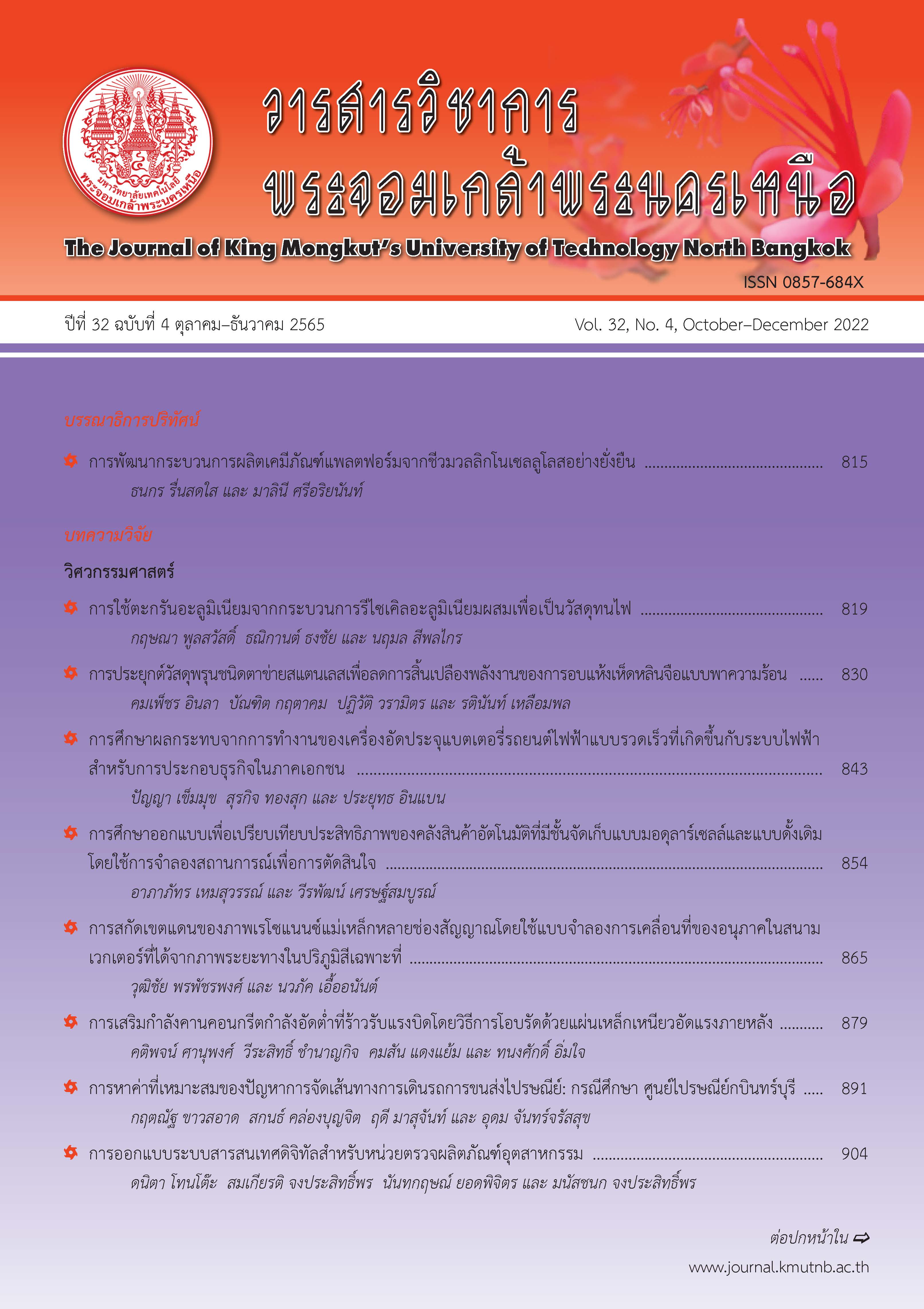The Use of Aluminum Dross in Refractory Materials from the Recycling Process of Aluminum Alloys
Main Article Content
Abstract
This research studies an application of aluminum dross, that is solid waste from aluminum alloys recycling process. The main objective of this study is to obtain the benefit from waste material utilization. Basically, alumina is the main composition for producing high alumina refractory. In this research the aluminum dross was studied the primary chemical composition by using XRD and XRF techniques in order to monitor the alumina composition from aluminum dross. It was found that alumina is the major chemical composition with 81.6 wt% followed by silica with 5.6 wt%. The aluminum dross was mixed with alumina and silica (industrial grade) by using the ratio of 100 : 0 : 0, 80 : 10 : 10 and 60 : 20 : 20, respectively. The mixing powder were compressed at 4,000 lb/in2 and then all samples were sintered at 1300, 1350 and 1,400 degrees Celsius for 2 hours. The compressive strength, bulk density and thermal conductivity coefficient were analyzed. It was found that the sample with the aluminum dross : alumina : silica at the ratio of 80 : 10 : 10 sintered at 1300 degrees Celsius provided the value of the compressive strength, bulk density and thermal conductivity coefficient of approximately 54.3 MPa, 2.2 g/cm3 and 1.8 W/m.K, respectively. These values show the sample with the ratio of 80 : 10 : 10 is suitable for using as high alumina refractories, referring to standard of KB-50 refractory materials.
Article Details

This work is licensed under a Creative Commons Attribution-NonCommercial-NoDerivatives 4.0 International License.
The articles published are the opinion of the author only. The author is responsible for any legal consequences. That may arise from that article.
References
A. Li, H. Zhang, and H. Yang, “Evaluation of aluminum dross as raw material for highalumina refractory,” Ceramics International, vol. 48, no. 8, pp. 12585–12590, September 2014.
P. Poonnayam, P. Yaempern, and K. Kimapong. (2012). Feasibility study of aluminum dross as alloying component of refractory brick. [Online] (in Thai). Available: http://www.research.rmutt.ac.th
P. Koonmee, W. Songserm, and T. Wuttipornpun, “The use of granular blast furnace slag in concrete manufacturing: Statistical analysis,” The Journal of KMUTNB, vol. 24, no. 1, pp. 103– 110, 2014 (in Thai).
M. C. Shinzato and R. Hypolito, “Solid waste from aluminum recycling process: Characterization and reuse of its economically valuable constituents,” Waste Management, vol. 25, no. 1, pp. 37–46, 2005.
A. Meshram and K. K. Singh, “Recovery of valuable products from hazardous aluminum dross: A review,” Resource, Conservation & Recycling, vol. 130, pp. 95–108, March 2018.
S. Freti, J. D. Bornand, and K. Buxman, “Metallurgy of dross formation on Al melts,” in Proceedings of Technical Sessions Sponsored by the TMS Light Metal Committee at the 111th AIME Annual Meeting, 1982, pp. 143–144.
J. Hong, J. Wang, H. Chen, B. Sun, J. Li, and C. Chen, “Process of aluminum dross recycling and life cycle assessment for Al-Si alloys and brown fused alumina,” Transactions of Nonferrous Metals Society of China, vol. 20, no. 11, pp. 2155– 2161, 2010.
L. O. Osoba, O. B. Owolabi, S. I. Talabi, and S. O. Adeosun, “Review on oxide formation and aluminum recovery mechanism during secondary smelting,” Journal of Casting & Materials Engineering, vol. 2, no. 2, pp. 45–51, 2018.
B. R. Das, B. Dash, B. C. Tripathy, I. N. Bhattacharya, and S. C. Das, “Production of η-alumina from waste aluminium dross,” Mineral Engineering, vol. 20, no. 3, pp. 252–258, 2007.
S. Capuzzi and G. Timelli, “Preparation and melting of scrap in aluminum recycling: A review,” Metals, vol. 8, no. 249, pp. 1–24, 2018.
O. Manfredi, W. Wuth, and I. Bohlinger, “Characterizing the physical and chemical properties of aluminum dross,” The Journal of The Minerals, Metals & Materials Society, vol. 49, pp. 48–51, 1997.
D. Bajare, A. Korjakins, J. Kazjonovs, and I. Rozenstrauha, “Pore structure of lightweight clay aggregate incorporate with non-metallic products coming from aluminium scrap recycling industry,” Journal of the European Ceramic Society, vol. 32, no. 1, pp. 141–148, January 2012.
A. M. Amer, “Extraction aluminum from dross tailings,” The Journal of The Minerals, Metal & Materials Society, vol. 54, pp. 72–75, November 2002.
Siam Refractory. (2021). Refractory User Guide. [Online] (in Thai). Available: http://www.stprefractory. com/Files/Name2/CONTENT8048 59332372.pdf
Thai s.s. Refractory. (2020). KB-50. [Online] (in Thai). Available: https://www.tssrefractory.com/ product/kb-50/
L. Labjaturaput. (1999). Refractory Materials. [Online] (in Thai). Available: https://library.dmr. go.th
W. Ryan and C. Radford, Whitewares: Production, Testing and Quality Control: Including Materials, Body Formulations and Manufacturing Processes. Oxford: Institute of Ceramics by Pergamon Press, 1987.

